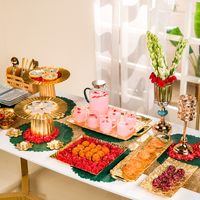Ram Navami, marking the birth of Lord Rama, is a deeply revered festival in Hindu culture. Celebrated on the ninth day of Chaitra Navratri, it’s a day that brings families together in prayer, devotion, and shared meals. Central to this celebration is the tradition of preparing and offering prasad—sacred food blessed by divinity and shared with loved ones.

Across India, the ritual of prasad is more than just a culinary tradition—it's a spiritual practice that embodies love, purity, and gratitude. In North Indian homes, age-old recipes are passed down through generations to mark the occasion with simplicity and sanctity.
Why Prasad is Important in Ram Navami?
Offering prasad to Lord Rama isn’t just symbolic—it’s an act of surrender and devotion. Food, lovingly prepared and humbly offered, becomes a medium to express faith.
Each ingredient used carries its own symbolism:
Wheat flour represents sustenance
Ghee symbolises purity
Jaggery adds the sweetness of devotion
Fruits and nuts reflect nature’s bounty
Ram Navami prasad is typically sattvic—free from onion, garlic, or heavy spices—making it suitable for fasting and deeply spiritual in essence.
Explore cooking essentials: https://nestasia.in/collections/kitchen
Traditional North Indian Prasad Recipes
1. Sooji Halwa (Sacred Semolina Sweet)
Ingredients:
1 cup semolina (sooji)
½ cup ghee
¾ cup sugar
2 cups water
Cardamom powder
Chopped nuts (cashews, almonds, raisins)

Preparation:
Heat ghee in a pan and roast the sooji till golden brown and aromatic.
In a separate pan, dissolve sugar in water and bring to a boil.
Slowly add the sugar syrup to the roasted sooji, stirring continuously.
Add cardamom and chopped nuts.
Cook until the halwa thickens and leaves the sides of the pan.
Explore serveware: https://nestasia.in/collections/bowls-main-menu
Why it’s a must-have:
Sooji Halwa is a staple in bhog thalis offered to deities. Its rich texture and comforting warmth make it an eternal festive favourite.
2. Kala Chana & Poori (Classic Ram Navami Prasad)
Ingredients for Kala Chana:
1 cup black chickpeas (soaked overnight)
Cumin, hing, ginger, green chilli
Rock salt
Ghee
Ingredients for Poori:
2 cups wheat flour
Water, ghee, rock salt
Preparation:
Boil soaked chana till soft. In a pan, heat ghee, add cumin, hing, and chopped ginger.
Add boiled chana, salt, and sauté well.
For pooris, knead dough, roll into discs, and deep-fry until golden.
Why it’s significant:
This combination is widely distributed in temples and homes. It’s filling, nutritious, and reflects simplicity—just like Lord Rama’s life.
3. Aloo Kadhi (Simple Yet Flavorful Fasting Dish)
Ingredients:
2 boiled potatoes
1 cup curd (diluted)
2 tbsp singhare ka atta or kuttu atta
Rock salt, cumin, green chill
Preparation:
Mix flour with curd and water. Heat ghee in a pan, add cumin and chillies.
Pour in the curd mixture and bring to a gentle boil.
Add cubed boiled potatoes and simmer for 10–15 mins.
Why it’s made for fasts:
Light, easy to digest, and packed with flavour, this kadhi is perfect for Ram Navami upvas (fasting).

4. Makhana Kheer (Nutritious Fox Nut Pudding)
Ingredients:
1 cup makhana (fox nuts)
2 cups milk
Ghee, cardamom powder
Sugar or jaggery
Chopped dry fruits
Preparation:
Roast makhanas in ghee till crisp. Crush slightly.
Boil milk and add makhana.
Simmer till thickened, then add sugar, cardamom, and dry fruits.
Why it’s vrat-friendly:
Makhana is packed with nutrition and approved for fasting diets. This kheer is creamy, sweet, and light—just right for sacred days.
5. Panjeeri (Wholesome Roasted Flour Prasad)
Ingredients:
1 cup wheat flour
½ cup ghee
½ cup powdered sugar or jaggery
Nuts, raisins, dry ginger (sonth)
Preparation:
Roast flour in ghee until golden and aromatic.
Add dry fruits and roast further.
Once cool, mix in powdered sugar or jaggery.
Why it’s a temple staple:
Known for its energy-boosting properties, panjeeri is often offered in temples and distributed to devotees for its nourishing benefits.
Tips for Preparing Festive Prasad
Use fresh, sattvic ingredients: Avoid onion, garlic, or overly spicy components. Keep it clean and wholesome.
Cook with devotion: Chant mantras, maintain a calm mind, and treat the cooking process as a form of prayer.
Serve with love: Use clean steel, silver, or banana leaf plates. Offer first to the deity before sharing with others.
Explore plates and platters: https://nestasia.in/collections/plate
Conclusion
Ram Navami is not just about rituals—it’s about reconnecting with our roots and celebrating divinity through the simplest of acts. Cooking and sharing prasad brings families together and fills homes with spiritual energy and joy.
So, this Ram Navami, honour tradition in your kitchen. Try these prasad recipes and pass on the legacy of sacred flavours and loving devotion.




















